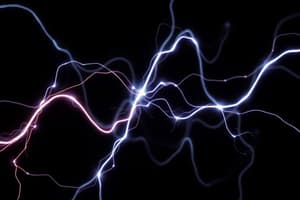Podcast
Questions and Answers
What does the concept of electric flux describe?
What does the concept of electric flux describe?
- The energy between two objects with similar charges
- The force between two objects with opposite charges (correct)
- The speed of electrons in a conductor
- The mass of charged particles
How is electric flux often represented?
How is electric flux often represented?
- By the letter B
- By the symbol α
- By the Greek letter Phi (Φ) (correct)
- By the letter E
What happens when charged particles interact with each other according to the text?
What happens when charged particles interact with each other according to the text?
- They create an electric field around them (correct)
- They become neutral
- They change color based on their charge
- They generate a gravitational field
In simple terms, how can electric flux be compared according to the text?
In simple terms, how can electric flux be compared according to the text?
What happens to the leftover energy known as electric flux when charge flows past any point along its path?
What happens to the leftover energy known as electric flux when charge flows past any point along its path?
What is one practical application of electric flux mentioned in the text?
What is one practical application of electric flux mentioned in the text?
Why is monitoring electric flux important during the construction phase of certain structures?
Why is monitoring electric flux important during the construction phase of certain structures?
How does electric flux play a role in understanding how light behaves?
How does electric flux play a role in understanding how light behaves?
Why do scientists study electric fields comprehensively using suitable methods?
Why do scientists study electric fields comprehensively using suitable methods?
What helps people better understand basic concepts related to electronic devices and optical systems mentioned in the text?
What helps people better understand basic concepts related to electronic devices and optical systems mentioned in the text?
Flashcards are hidden until you start studying
Study Notes
Understanding Electric Flux
Electric flux is a concept from classical electromagnetism that describes how much force (or energy) exists between two objects with opposite charges. It's often represented by the Greek letter Phi (Φ), which makes it relatively easy to remember.
The basic principle behind electric flux was developed during the 19th century when scientists started investigating electricity and magnetism more closely. With this knowledge, they discovered that all charged particles have both an electric field around them, as well as magnetic fields depending on their orientation in space. Since these fields interact with each other, a certain amount of electric energy leaks out into free space – this leakage is called electric flux.
In simple terms, electric flux can be thought of like water flowing through a pipe — if you take away some water from one end and put some back in another end, there will always be an amount left over sitting idle within the system itself. Likewise, whenever charge flows past any point along its path, it leaves behind some 'leftover' energy known as electric flux. This leftover energy remains available until something absorbs or uses up that stored power somewhere else within your circuitry network; hence why we speak of potential difference being present where electrical current travels over time.
Applications of Electric Flux
There are several common practical applications involving electric flux which are worth mentioning here:
For instance, imagine building an antenna. An antenna works because it has different parts designed so they reflect radio waves coming towards them differently according to what angle those waves arrive from. Because of this property of reflection, every single part inside such an array must produce exactly the same voltage output under identical conditions at given frequencies - otherwise those signals won’t send messages properly! So we need precise control over how much energy escapes due to electrostatic forces acting upon our structure - thus monitoring electric flux becomes extremely important during construction phase.
Similarly, electric flux plays a role in understanding how light behaves too. Electromagnetic radiation consists largely of photons traveling freely throughout space (like tiny packets carrying information about color or temperature); however sometimes these photons meet matter particles; when they do so, each packet bounces off slightly differently than before causing refraction & diffraction effects observed in everyday life. Therefore measuring changes occurring locally near surfaces affected by these phenomena helps us predict outcomes of various optical experiments better based solely upon principles concerning relationships between geometry/material properties leading directly from conserved laws governing electric field behavior.
Moreover scientific investigation requires careful calibration before making accurate statements regarding physical quantities measured experimentally; therefore scientists study electric fields comprehensively using suitable methods relating observable parameters associated with said fields eg electric displacement vector E = dΨ_e/dV etc., instead relying purely on intuitive visualizations derived without considering underlying mathematical formalisms involved extensively used later stages work involving theoretical derivations.
In summary, while initially complex due to technical jargon surrounding definition pure mathematically speaking , once understood or grasped intuitively through concrete examples found across daily living experiences most people find basic concepts related electronic devices/optical systems powered electronically quite interesting indeed!
Studying That Suits You
Use AI to generate personalized quizzes and flashcards to suit your learning preferences.




